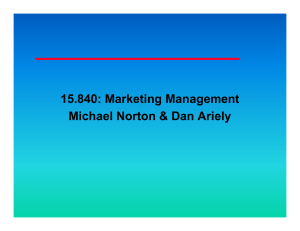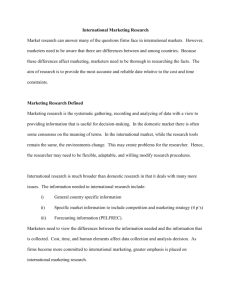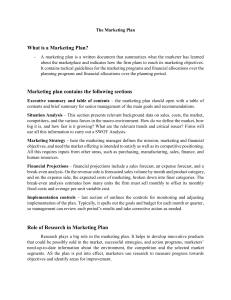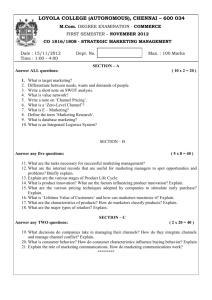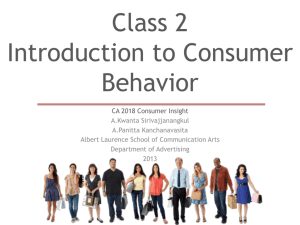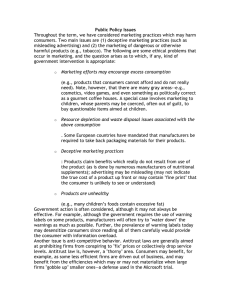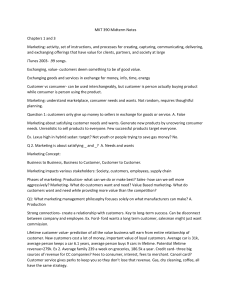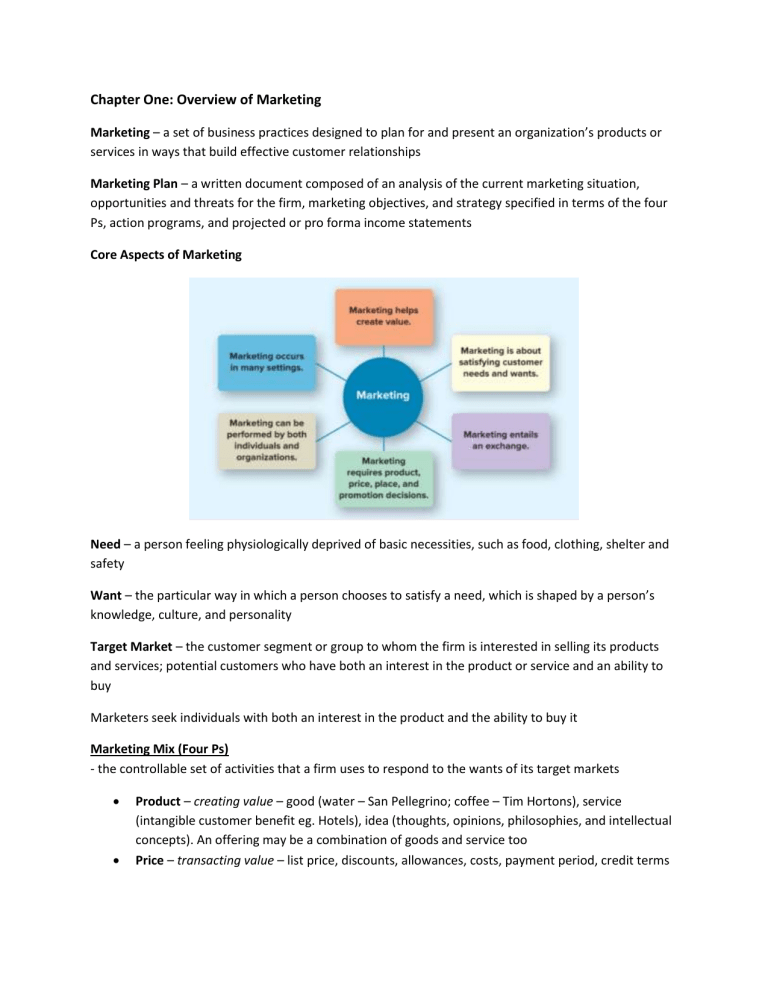
Chapter One: Overview of Marketing Marketing – a set of business practices designed to plan for and present an organization’s products or services in ways that build effective customer relationships Marketing Plan – a written document composed of an analysis of the current marketing situation, opportunities and threats for the firm, marketing objectives, and strategy specified in terms of the four Ps, action programs, and projected or pro forma income statements Core Aspects of Marketing Need – a person feeling physiologically deprived of basic necessities, such as food, clothing, shelter and safety Want – the particular way in which a person chooses to satisfy a need, which is shaped by a person’s knowledge, culture, and personality Target Market – the customer segment or group to whom the firm is interested in selling its products and services; potential customers who have both an interest in the product or service and an ability to buy Marketers seek individuals with both an interest in the product and the ability to buy it Marketing Mix (Four Ps) - the controllable set of activities that a firm uses to respond to the wants of its target markets Product – creating value – good (water – San Pellegrino; coffee – Tim Hortons), service (intangible customer benefit eg. Hotels), idea (thoughts, opinions, philosophies, and intellectual concepts). An offering may be a combination of goods and service too Price – transacting value – list price, discounts, allowances, costs, payment period, credit terms Promotion – communicating value – advertising, sales promotion, personal selling, public relations Place – delivering value – marketing channels, distribution intensity, location (retailers, online) Although marketers deliver value through each of the 4Ps individually, far greater value is created when the 4Ps are provided as a whole. That is, the product or service offered must satisfy the target customers’ specific needs and wants, be priced appropriately, be available at locations where customers want it, and be promoted in a manner and through media that are consistent with the target consumers Eg. Coach, LV: well made, priced at a premium, available at exclusive locations, and promoted only in certain media where the advertisements emphasize style, fashion, sex appeal B2C – business to consumers – the process in which businesses sell to consumers B2B – business to business – the process of selling merchandise or services from one business to another Companies like GE are engaged in both at the same time. C2C – consumer to consumer – the process in which consumers sell to other consumers. Eg. Kijiji, PayPal Four Orientations of Marketing Product Orientation – beginning of 20th century – firms believed that a good product would sell itself, focus is on developing and distributing innovative products with little concern about whether those products actually satisfy customer needs and wants Sales Orientation– 1920 to 1950 – manufacturers had the capacity to produce more than customers really wanted – firms depended on heavy doses of personal selling and advertising, marketing is more of a sales function and focus is on selling as many of their products as possible without really think of customer needs. Market Orientation – manufacturers turned from focusing on the war effort and toward consumer products – consumers again had choices so manufacturers and retailers began to focus on what consumers wanted and needed before they designed and attempted to sell their products/services Value Orientation – firms attempt to discover and satisfy their customers’ needs and wants - to compete, they would have to give their customers greater value than their competitors Value – reflects the relationship of benefits to costs, or what the consumer gets for what he or she gives Value-Based Marketing – marketing that focuses on providing customers with benefits that far exceed the cost (money, time, effort) of acquiring and using a product or service while providing a reasonable return to the firm How do firms become value driven? 1. Sharing Information they share information about their customers and competitors across their own organization and with other firms that might be involved in getting the product or service to the marketplace, such as manufacturers and transportation companies marketers share info about customers and competitors that has been collected through customer relationship management, and integrate it across the firm’s various departments Eg – Zara collects information from purchase information and research customer trends to determine what their customers will want to wear in the next few weeks 2. Balancing Benefits with Costs marketers constantly measure the benefits that customers perceive against the cost of their offering they use available customer data to find opportunities in which they can better satisfy their customers’ needs and in turn develop long-term loyalties Eg. Walmart, Canadian Tire, WestJet 3. Building Relationships with Customers marketers have begun to realize that they need to think about their customer orientation in terms of relationships rather than transactions Transactional Orientation – regards the buyer-seller relationship as a series of individual transactions, so anything that happened before or after the transaction is of little importance - used car sales – buyer wants lowest price, seller wants highest price, likely won’t do business again Relational Orientation – a method of building a relationship with customers based on the philosophy that buyers and sellers should develop a long-term relationship Customer Relationship Management (CRM) – a business philosophy and set of strategies, program and systems that focus on identifying and building loyalty among the firm’s most valued customers - collect info about their customers’ needs and use that info to target their best customers with the products, services and special promotions that appear most important to them Supply Chain – the group of firms that make and deliver a given set of goods and services Why is Marketing Important

